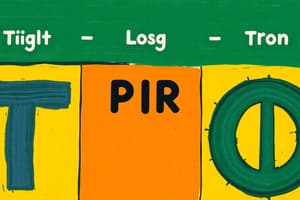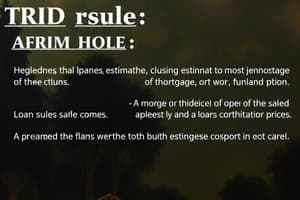Podcast
Questions and Answers
What was one of the main reasons why the Dodd-Frank Act mandated the integration of mortgage disclosures?
What was one of the main reasons why the Dodd-Frank Act mandated the integration of mortgage disclosures?
- To simplify the process for lenders by reducing the number of disclosures required.
- To make it easier for consumers to compare different loan offers.
- To ensure that consumers understood the terms of their loan.
- All of the above (correct)
What is the current name for the integrated mortgage disclosure forms, as outlined in the TRID rule?
What is the current name for the integrated mortgage disclosure forms, as outlined in the TRID rule?
- Final Truth in Lending Disclosure & HUD-1 Settlement Statement
- Loan Estimate and Closing Disclosure (correct)
- HUD-1 Settlement Statement & Truth-in-Lending Disclosure
- Good Faith Estimate and Truth-in-Lending Disclosure.
Which of the following is NOT covered under the scope of the TRID rule?
Which of the following is NOT covered under the scope of the TRID rule?
- Purchase transactions involving a primary residence.
- Home Equity Lines of Credit (HELOCs) (correct)
- Refinance transactions on a primary residence
- Reverse mortgages.
Under the TRID rule, who is responsible for the accuracy of the Loan Estimate and Closing Disclosure?
Under the TRID rule, who is responsible for the accuracy of the Loan Estimate and Closing Disclosure?
What regulation was amended to include the TRID requirements?
What regulation was amended to include the TRID requirements?
What date did the TRID rules become effective?
What date did the TRID rules become effective?
Which of the following accurately describes the types of transactions that are NOT covered by TRID?
Which of the following accurately describes the types of transactions that are NOT covered by TRID?
What is the main purpose of the TRID rule, as stated in the provided text?
What is the main purpose of the TRID rule, as stated in the provided text?
When are mortgage lenders obligated to provide a free copy of appraisal reports to the borrower?
When are mortgage lenders obligated to provide a free copy of appraisal reports to the borrower?
Which of these disclosures must be given along with the Loan Estimate?
Which of these disclosures must be given along with the Loan Estimate?
What is the primary purpose of the "Your Home Loan Toolkit" booklet?
What is the primary purpose of the "Your Home Loan Toolkit" booklet?
Which of these disclosures is related to the escrow account for property taxes and insurance?
Which of these disclosures is related to the escrow account for property taxes and insurance?
Under what circumstances can the 3-day provision requirement for appraisal disclosure be waived?
Under what circumstances can the 3-day provision requirement for appraisal disclosure be waived?
Under what circumstances is a revised Loan Estimate (LE) required?
Under what circumstances is a revised Loan Estimate (LE) required?
What is the minimum time period a lender must provide a revised Loan Estimate before the loan consummation?
What is the minimum time period a lender must provide a revised Loan Estimate before the loan consummation?
Which of the following is NOT a method lenders can use to cure tolerance violations?
Which of the following is NOT a method lenders can use to cure tolerance violations?
When is a Closing Disclosure considered received by the borrower?
When is a Closing Disclosure considered received by the borrower?
What are the requirements for a borrower to modify or waive the three-day waiting period after receiving the Closing Disclosure?
What are the requirements for a borrower to modify or waive the three-day waiting period after receiving the Closing Disclosure?
What is the maximum time frame a lender has to provide a corrected Closing Disclosure if changes occur after the initial disclosure is issued?
What is the maximum time frame a lender has to provide a corrected Closing Disclosure if changes occur after the initial disclosure is issued?
Which of the following situations does NOT require an additional three-day waiting period before closing after a corrected Closing Disclosure is issued?
Which of the following situations does NOT require an additional three-day waiting period before closing after a corrected Closing Disclosure is issued?
In the event of a rescission, when does the three-day right of rescission period begin?
In the event of a rescission, when does the three-day right of rescission period begin?
Which page of the Closing Disclosure contains a final accounting of fees and charges, including any changes from the Loan Estimate?
Which page of the Closing Disclosure contains a final accounting of fees and charges, including any changes from the Loan Estimate?
What purpose does the "Summaries of Transactions" section on the Closing Disclosure serve?
What purpose does the "Summaries of Transactions" section on the Closing Disclosure serve?
What type of information is presented on Page 4 of the Closing Disclosure?
What type of information is presented on Page 4 of the Closing Disclosure?
Which of the following is NOT presented on Page 5 of the Closing Disclosure?
Which of the following is NOT presented on Page 5 of the Closing Disclosure?
Why does the Closing Disclosure contain final disclosures of loan terms and total closing costs?
Why does the Closing Disclosure contain final disclosures of loan terms and total closing costs?
What is the primary difference between the Closing Disclosure for a purchase transaction and the one for a refinance transaction?
What is the primary difference between the Closing Disclosure for a purchase transaction and the one for a refinance transaction?
What is the significance of the Tolerance Limits being reset when a revised Closing Disclosure is issued?
What is the significance of the Tolerance Limits being reset when a revised Closing Disclosure is issued?
Which of the following is NOT a category of loan costs?
Which of the following is NOT a category of loan costs?
What is the definition of a 'business day' for the purposes of providing a Closing Disclosure?
What is the definition of a 'business day' for the purposes of providing a Closing Disclosure?
When does 'loan consummation' typically occur?
When does 'loan consummation' typically occur?
What is a 'Lender credit'?
What is a 'Lender credit'?
What does 'intent to proceed' mean in the context of TRID?
What does 'intent to proceed' mean in the context of TRID?
What is the purpose of the 'Cash to Close' calculation?
What is the purpose of the 'Cash to Close' calculation?
Which of the following can be considered a 'changed circumstance' for the purposes of providing a revised Loan Estimate or Closing Disclosure?
Which of the following can be considered a 'changed circumstance' for the purposes of providing a revised Loan Estimate or Closing Disclosure?
What is the purpose of the Loan Estimate (LE)?
What is the purpose of the Loan Estimate (LE)?
Which of the following details is NOT typically included in Page 3 of the Loan Estimate?
Which of the following details is NOT typically included in Page 3 of the Loan Estimate?
The TRID rule requires the use of two Integrated Disclosures. What are they?
The TRID rule requires the use of two Integrated Disclosures. What are they?
When is the lender required to deliver or mail the Loan Estimate to the consumer?
When is the lender required to deliver or mail the Loan Estimate to the consumer?
What is the 'Settlement Service Providers list'?
What is the 'Settlement Service Providers list'?
What are the six pieces of information required by RESPA for an application to be considered 'made'?
What are the six pieces of information required by RESPA for an application to be considered 'made'?
What is the 'good faith' requirement for the Loan Estimate?
What is the 'good faith' requirement for the Loan Estimate?
What is the 'Zero Tolerance' category for fee variances?
What is the 'Zero Tolerance' category for fee variances?
What is the purpose of the Loan Estimate form?
What is the purpose of the Loan Estimate form?
In certain situations, mortgage brokers may provide a Loan Estimate. However, who is ultimately responsible for any errors or defects?
In certain situations, mortgage brokers may provide a Loan Estimate. However, who is ultimately responsible for any errors or defects?
Under what circumstances does the lender not have to provide a Loan Estimate?
Under what circumstances does the lender not have to provide a Loan Estimate?
Which of the following is an example of a 'No Tolerance' category for fee variances?
Which of the following is an example of a 'No Tolerance' category for fee variances?
What is the typical waiting period before loan consummation after the borrower receives the Loan Estimate?
What is the typical waiting period before loan consummation after the borrower receives the Loan Estimate?
When is a revised Loan Estimate required?
When is a revised Loan Estimate required?
What conditions must be met for the borrower to modify or waive the seven-business-day waiting period?
What conditions must be met for the borrower to modify or waive the seven-business-day waiting period?
Which of the following is NOT considered a valid 'change of circumstances' that would require a revised Loan Estimate?
Which of the following is NOT considered a valid 'change of circumstances' that would require a revised Loan Estimate?
What is a 'yield spread premium'?
What is a 'yield spread premium'?
What information is typically included on Page 1 of the Loan Estimate form?
What information is typically included on Page 1 of the Loan Estimate form?
What is the relationship between TRID and RESPA?
What is the relationship between TRID and RESPA?
What is the difference between 'Lender-required' and 'Lender-selected' services?
What is the difference between 'Lender-required' and 'Lender-selected' services?
What is the purpose of the Loan Estimate (LE) disclosure?
What is the purpose of the Loan Estimate (LE) disclosure?
What is the difference between APR and TIP?
What is the difference between APR and TIP?
In regard to settlement services, what is a lender's responsibility if the borrower chooses a provider not on the lender's list?
In regard to settlement services, what is a lender's responsibility if the borrower chooses a provider not on the lender's list?
Why is it important for lenders to act in good faith and exercise due diligence when completing the Loan Estimate?
Why is it important for lenders to act in good faith and exercise due diligence when completing the Loan Estimate?
Flashcards
Dodd-Frank Act
Dodd-Frank Act
Federal law aimed at reducing risks in the financial system.
RESPA
RESPA
Real Estate Settlement Procedures Act, requires disclosure of settlement costs.
TILA
TILA
Truth in Lending Act, mandates clear disclosure of loan terms.
TRID
TRID
Signup and view all the flashcards
Loan Estimate
Loan Estimate
Signup and view all the flashcards
Closing Disclosure
Closing Disclosure
Signup and view all the flashcards
CFPB
CFPB
Signup and view all the flashcards
Exclusions to TRID
Exclusions to TRID
Signup and view all the flashcards
Your Home Loan Toolkit
Your Home Loan Toolkit
Signup and view all the flashcards
Affiliated Business Disclosure
Affiliated Business Disclosure
Signup and view all the flashcards
Initial Escrow Account Statement
Initial Escrow Account Statement
Signup and view all the flashcards
Annual Escrow Account Statement
Annual Escrow Account Statement
Signup and view all the flashcards
Appraisal Requirements
Appraisal Requirements
Signup and view all the flashcards
TRID Disclosure Requirements
TRID Disclosure Requirements
Signup and view all the flashcards
Annual Percentage Rate (APR)
Annual Percentage Rate (APR)
Signup and view all the flashcards
Total Interest Percentage (TIP)
Total Interest Percentage (TIP)
Signup and view all the flashcards
Loan Consummation
Loan Consummation
Signup and view all the flashcards
Business Day Definition (Loan Estimate)
Business Day Definition (Loan Estimate)
Signup and view all the flashcards
Business Day Definition (Closing Disclosure)
Business Day Definition (Closing Disclosure)
Signup and view all the flashcards
Intent to Proceed
Intent to Proceed
Signup and view all the flashcards
Changed Circumstance
Changed Circumstance
Signup and view all the flashcards
Integrated Disclosures
Integrated Disclosures
Signup and view all the flashcards
Loan Estimate Delivery Time
Loan Estimate Delivery Time
Signup and view all the flashcards
Application Trigger
Application Trigger
Signup and view all the flashcards
Good Faith Estimate
Good Faith Estimate
Signup and view all the flashcards
Waiving Loan Estimate Waiting Period
Waiving Loan Estimate Waiting Period
Signup and view all the flashcards
Loan Estimate Form Structure
Loan Estimate Form Structure
Signup and view all the flashcards
Page 1 of Loan Estimate
Page 1 of Loan Estimate
Signup and view all the flashcards
Loan Costs
Loan Costs
Signup and view all the flashcards
Origination Charges
Origination Charges
Signup and view all the flashcards
Third-party Charges
Third-party Charges
Signup and view all the flashcards
Initial Escrow Payments
Initial Escrow Payments
Signup and view all the flashcards
Lender Credits
Lender Credits
Signup and view all the flashcards
Cash to Close Calculation
Cash to Close Calculation
Signup and view all the flashcards
TRID Rule
TRID Rule
Signup and view all the flashcards
Zero Tolerance Category
Zero Tolerance Category
Signup and view all the flashcards
Ten Percent Tolerance
Ten Percent Tolerance
Signup and view all the flashcards
No Tolerance Charges
No Tolerance Charges
Signup and view all the flashcards
Settlement Service Providers List
Settlement Service Providers List
Signup and view all the flashcards
Change of Circumstances
Change of Circumstances
Signup and view all the flashcards
Revised Loan Estimate (LE)
Revised Loan Estimate (LE)
Signup and view all the flashcards
Prepaids
Prepaids
Signup and view all the flashcards
Homeowners Insurance
Homeowners Insurance
Signup and view all the flashcards
Tolerance Violations
Tolerance Violations
Signup and view all the flashcards
Cure for Tolerance Violations
Cure for Tolerance Violations
Signup and view all the flashcards
Closing Disclosure Timing
Closing Disclosure Timing
Signup and view all the flashcards
Right of Rescission
Right of Rescission
Signup and view all the flashcards
Corrections after Closing
Corrections after Closing
Signup and view all the flashcards
Three-day Waiting Period
Three-day Waiting Period
Signup and view all the flashcards
CD vs. LE
CD vs. LE
Signup and view all the flashcards
Loan Disclosure Requirements
Loan Disclosure Requirements
Signup and view all the flashcards
Revised CD
Revised CD
Signup and view all the flashcards
Page Structure of CD
Page Structure of CD
Signup and view all the flashcards
Final APR Requirements
Final APR Requirements
Signup and view all the flashcards
Effect of Selling Costs
Effect of Selling Costs
Signup and view all the flashcards
Borrower's Written Statement
Borrower's Written Statement
Signup and view all the flashcards
Study Notes
TRID (TILA-RESPA Integrated Disclosure) Rule Summary
- TRID replaced previous dual disclosure requirements (RESPA and TILA) with integrated forms (Loan Estimate and Closing Disclosure) for most federally related mortgage loans.
- Effective October 3, 2015.
- Designed to improve consumer understanding of loan terms.
- Lenders are responsible for the accuracy of both the Loan Estimate (LE) and Closing Disclosure (CD). Settlement agents responsible only for Seller Closing Disclosure on purchase transactions.
- Specific forms for refinance and purchase transactions.
- Applies to most closed-end consumer credit transactions secured by real property or co-op unit.
Loan Estimate (LE)
- Replaces the GFE and initial TILA disclosure.
- Must be delivered/mailed within 3 business days of application receipt.
- 6 pieces of specific application information needed (borrower info, income, SSN, property address, value estimate, loan amount)
- Must contain good faith estimates of costs and terms
- Provided in person, by mail, or electronically (with consumer consent).
- Must be delivered at least 7 business days before consummation.
- A seven-day waiting period can be modified or waived for a valid personal financial emergency that is addressed by closing sooner.
- Specific "changed circumstances" allow for revision and resetting of tolerance limits.
Closing Disclosure (CD)
- Replaces the final TILA disclosure and HUD-1 settlement statement.
- Must be delivered no later than 3 business days before consummation.
- Must include actual transaction terms and costs.
- Received when provided in person (signed and dated), 3 business days after mailed, or upon delivery electronically.
- Three-day waiting period before consummation can be modified or waived for a valid personal financial emergency.
- Revised CD required if terms/costs change or if needed to correct errors.
- A three-day period may be added if disclosures of APR, loan product, or prepayment penalties change.
TRID Terminology and Key Concepts
- Annual Percentage Rate (APR): Includes all fees and expressed in percentage.
- Total Interest Percentage (TIP): Calculates total interest over the life of the loan compared to the loan amount.
- Loan Consummation: Legally distinct from loan closing. Occurs when the consumer is contractually obligated to the lender.
- Business Day: Defined differently for LE (business-open day) and CD (weekdays but not Sunday or public holidays).
- Intent to Proceed: Important for fees and credit card processing; a consumer's expression of intent to proceed must be recorded by the lender.
- Changed Circumstances: A particular event beyond either party's control or unexpected events specific to the consumer or loan.
- Tolerance Categories: Allow for some variance between estimated and actual costs. Zero Tolerance applies to specific lender charges, 10% tolerance for aggregate costs (with change-of-circumstances requirements for greater variances).
Additional TRID Requirements & Considerations
- Loan Estimate Form: Three-page format, with breakdown of closing costs, and other loan terms
- Closing Disclosure Form: Five-page format, very similar to the Loan Estimate but with more detailed information including a breakdown of seller and other payments.
- The "Your Home Loan Toolkit" booklet replaces the HUD Special Information booklet.
- Affiliated Business Disclosure: If affiliated with settlement service providers, it must be disclosed.
- Initial Escrow Account Statement & Annual Escrow Account Statement: For monthly tax & insurance escrow accounts required by the loan terms.
- Appraisal Requirements: Lenders must provide a copy of appraisals within a certain period, usually 3 days before loan closes.
Exceptions and Non-Applicability
- HELOCs, reverse mortgages, chattel-dwelling loans, loans by non-creditors or with certain exceptions. These generally are not fully subject to TRID requirements, some may have provisions regarding TRID.
Studying That Suits You
Use AI to generate personalized quizzes and flashcards to suit your learning preferences.




